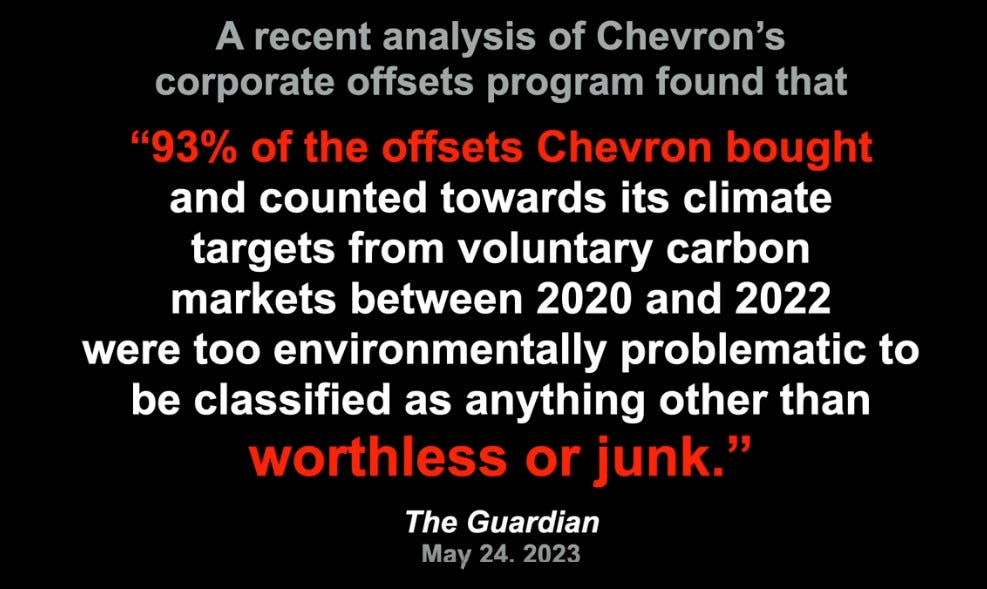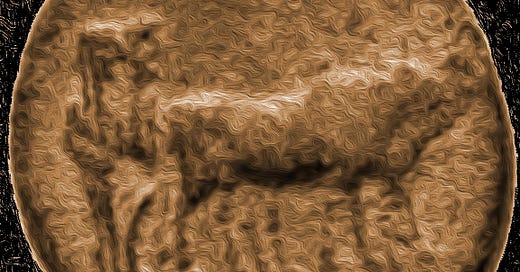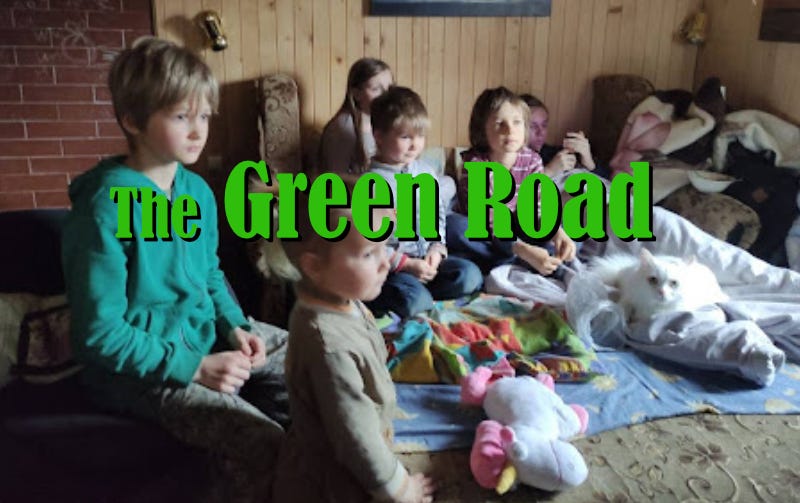A few thousand years after the glaciers retreated, the world’s soils, mineralized by dust dropped by melting and grinding ice, reached what might be called “peak carbon.” The end of the ice age marked a low ebb in the atmospheric CO2 tide, and gradually, as field grasses and new forests migrated into areas previously covered by ice, soil storage of carbon reached a zenith—10 to 12% by volume. The plant and animal respiratory cycle found its balance, an equilibrium state only disturbed by occasional volcanic cataclysms, massive wildfires, or droughts created by cycles that denuded great land masses. Earth has cycled through such states for an eternity. Until civilization arrived.
“What do you think of Western civilization, Mr. Gandhi?”
Gandhi: “I think it would be a very good idea.”
Civilization changed all that. Vast forests were cleared to build cities and feed armies. Cows replaced buffalo and wildebeest. As forests gave way to fields and fields gave way to pavement, the cycle of respiration shortened like an asthmatic’s when in search of an inhaler.
The exhaled breath of animals and people suddenly (within centuries) had nowhere to go. It stayed as carbon dioxide rather than being broken into its component parts. Carbon dioxide is a potent greenhouse gas because it admits light from space but traps heat bouncing off the planet’s surface. The Watts-per-square meter of Earth’s energy balance grew slowly at first, as the Fertile Crescent and Northeast China went from the lush river valley birthplaces of agriculture to sandy deserts.
Irrigation and the plow were ancient precursors of modern coal mines and oil wells.
When the nations of the world finally began waking up to the risk posed by overdevelopment and the moral imperative of sustainability, Earth was already out of balance.
"Development that meets the needs of the present without compromising the ability of future generations to meet their own needs….”
— Brundtland Report (1987)
The surplus in the sunlight retention ledger progressed over 6000 years to 0.5 W/m2. Put another way, thanks to human settlement patterns, agriculture, deforestation, drilling and mining, the planet's energy balance was too hot by half a Watt over every square meter of the planet.
Between 2006 and 2020, that imbalance jumped to 0.76 W/m2. That should scare everyone. Put enough of those square meters together and you can power a space heater or a steel plant, or even ignite Earth’s atmosphere like Edward Teller mused. The surface of the Earth has plenty of square meters, and that is a global average net gain—every second of every day.
The rate of change is the scariest part. We are on the wrong end of an exponential hockey stick.
Over the course of each year, land surfaces, oceans, and atmosphere absorb an average of about 340 Watts of solar power per square meter (one Watt is one joule of energy per second). The average intensity of solar energy reaching the top of the atmosphere directly facing the Sun (solar irradiance) is about 1,360 W/m2, according to measurements made by the most recent NASA satellite missions. About 29% of that energy is reflected back to space by clouds, atmospheric particles, or bright ground surfaces like sea ice and snow. This energy plays no role in Earth’s climate system. Another 23% is absorbed in the atmosphere by water vapor, dust, and ozone and 48% passes through the atmosphere and is absorbed by the surface where it provides the prerequisite energy for all forms of life on Earth.
I’m melting!
Water vapor is the single largest greenhouse gas and for a long time, climate activists ignored it because it was so large and so little of it was under human control the way CO2, methane, or CFCs are. Forests make water vapor. If you take away forests, the atmosphere has less cloud cover, which means less sunlight is reflected back to space (positive forcing) and also that a blanket keeping us warm has been taken off (negative forcing). On balance, the removal of forests since the start of agriculture has heated the planet more than cooled it.
The loss of ice at the poles further aggravates the situation. Long declared one of the “tipping elements” it now appears the point has tipped.
Think of a tipping point like a four-legged chair. You tip back and balance on the two back legs. It has a limited range of motion. If you lean back far enough, you pass a threshold beyond which recovery is no longer possible. The chair will fall backwards. Your new equilibrium state is flat on your back.
The planet's fulcrum is at the tipping point between the amount of energy that comes in from the Sun and the amount of energy that is radiated back to space. This balance is important for keeping the Earth's temperature at a relatively stable level.
Ice and snow have a high albedo, which means that they reflect a lot of sunlight. When ice and snow melt, the reflectivity of Earth's surface decreases and more sunlight is absorbed. There are cascading consequences:
The loss of sea ice is exposing dark ocean water, which absorbs more sunlight than reflective ice. This is causing the Arctic to warm at twice the rate of the rest of the planet.
The loss of ice on Greenland and Antarctica is causing the land to warm, which is melting more ice. This is a self-reinforcing process that is causing the ice sheets to lose mass at an accelerating rate.
As ice melts, it adds water to the oceans which speeds sea level rise. This is another feedback process that causes the ice sheets to lose mass at an accelerating rate.
Changes in weather patterns caused by warming leads to more frequent and severe storms, droughts, and floods which in turn melts more ice.
The loss of ice from the Arctic, Greenland, and Antarctica is already having a significant impact on Earth's climate, as the current new records for temperature, floods, and cold waves attest.
Beginning in the 1980s, when attempts to set up carbon taxes or UN carbon exchanges by law and treaty—so-called “compliance markets”— broke apart over political wrangling, unregulated “voluntary markets” began to experiment with ideas like carbon credits and offsets—offering polluters opportunities to buy back their pollution by planting trees or switching to no-till farming.
Offputting Offsets

The rapid expansion of carbon markets over the past few decades slowed in 2022 and 2023. One reason was a general reckoning with quality and methodology issues. A common issue was permanence. Early awards were often for long periods—as much as a century—without accounting for how climate change might bring greater rates of damage to farms and forests from drought, disease, pests, floods, wildfire, and extreme weather.
Other problems were “additionality”—claiming credit for forests that were naturally replenishing on their own—and “leakage”—selling credits for not cutting a forest but then supplying equivalent timber by cutting somewhere else. Another issue was lack of transparency, leading to abuses like double counting, exploitation of rural communities and tribes, and profiteering. Media scrutiny and reforms led to greater transparency, integrity, and higher volumes of quality carbon projects today. The UN responded by overhauling REDD—“Reduced Emissions from Deforestation and Degradation”—to mandate sustainable practices for biodiversity and protection of indigenous cultures and to give priority to the neediest nations. Most recently, the UN has told countries that purchased offsets may not be counted toward net zero goals.
While low-quality legacy credit programs still give reforestation a black eye, the new reforms that require auditors, insurers, and strict reporting have opened the doors to changing tree planters into tree growers. By de-risking start-up investments, the reformed carbon market has stood up entirely new commercial sectors such as biochar and other carbon capture technologies.
A market report by Sylbera, a carbon data firm, and Pachama, which provides satellite and AI monitoring services for carbon credits, says:
Despite challenges with legacy credits, limited high-quality supply, and continuing work on official guidance, the corporate demand for carbon credits is strong — and that’s unlikely to change. More and more corporate buyers are taking a more nuanced, impact-driven approach to carbon credit investments, becoming involved earlier in projects and focusing on contribution over ‘offsetting.’ Voluntary credit retirements held strong in 2022 and are on track to beat records in 2023. And although further market adjustments and developments will undoubtedly lead to smaller-scale highs and lows in future years, the overall trajectory for the VCM looks positive.
New technology and innovation will allow for better verification of legacy projects and produce a new generation of tech-enabled projects with built-in quality assurance. Regulatory bodies and standard-setters are working closely to build frameworks and guidance for a high-integrity voluntary carbon market. And corporate buyers are showing bold leadership, optimizing for quality, and looking to get involved with projects at the grassroots level.
I confess that in the early years of carbon trading, I had been skeptical. I called offsets “indulgences” because of how polluters could use their immoral profit advantage to keep polluting. That is the traditional environmentalist position taken by Greta Thunberg and her one-hundred co-authors for The Climate Book, which, despite minor flaws, I highly recommend. But something has changed. Lately, I have gotten to meet young inventors and business creators working at the cutting edge of climate solutions, and that has changed my mind. When they can count a measure of carbon drawdown into the fair value return for their products and services it does more than stimulate this new carbon economy. It rights a historic wrong. It internalizes a cost that was externalized from the economic models that run our society. In a small, toddling way, it put the cost of damage from extraction, waste, and pollution into the price of products.
Financial reform is a building block, one at the foundation of the new carbon economy. Those who continue to deride carbon trading have not been keeping pace with the latest developments. This is not your daddy’s offset trading system anymore.
Next week will continue exploring solutions with a hard numbers look at reforestation.
References
Fleischman, Forrest, et al. "Pitfalls of tree planting show why we need people-centered natural climate solutions." BioScience 70.11 (2020): 947-950.
Cochrane, J. 10 Trends Carbon Market Experts are Talking About Right Now (2023)
Lindsey, Rebecca. "Climate and earth’s energy budget." NASA Earth Observatory 680 (2009).
Lewis, Simon L., et al. "Restoring natural forests is the best way to remove atmospheric carbon." Nature 568.7750 (2019): 25-28.
Meanwhile, let’s end this war. Towns, villages, and cities in Ukraine are being bombed every day. Ecovillages and permaculture farms have organized something like an underground railroad to shelter families fleeing the cities, either on a long-term basis or temporarily, as people wait for the best moments to cross the border to a safer place or to return to their homes if that becomes possible. There are 70 sites in Ukraine and 500 around the region. As you read this, 24 Ukrainian ecovillages have given shelter to more than 2500 people (up to 500 children) and now host up to 1400 persons (around 200 children). We call our project “The Green Road.”
For most of the children refugees, this will be their first experience in ecovillage living. They will directly experience its wonders, skills, and safety. They may never want to go back. Those that do will carry the seeds within them of the better world they glimpsed through the eyes of a child.
Those wishing to make a tax-deductible gift can do so through Global Village Institute by going to http://PayPal.me/greenroad2022 or by directing donations to greenroad@thefarm.org.
There is more info on the Global Village Institute website at https://www.gvix.org/greenroad or you can listen to this NPR Podcast and read this recent article in Mother Jones. Thank you for your help.
The COVID-19 pandemic destroyed lives, livelihoods, and economies. But it has not slowed climate change, a juggernaut threat to all life, humans included. We had a trial run at emergency problem-solving on a global scale with COVID — and we failed. 6.95 million people, and counting, have died. We ignored well-laid plans to isolate and contact trace early cases; overloaded our ICUs; parked morgue trucks on the streets; incinerated bodies until the smoke obscured our cities as much as the raging wildfires. The modern world took a masterclass in how abysmally, unbelievably, shockingly bad we could fail, despite our amazing science, vast wealth, and singular talents as a species.
Having failed so dramatically, so convincingly, with such breathtaking ineptitude, do we imagine we will now do better with climate? Having demonstrated such extreme disorientation in the face of a few simple strands of RNA, do we imagine we can call upon some magic power that will arrest all our planetary-ecosystem-destroying activities?
As the world emerges into pandemic recovery (maybe), there is growing recognition that we must learn to do better. We must chart a pathway to a new carbon economy that goes beyond zero emissions and runs the industrial carbon cycle backward — taking CO2 from the atmosphere and ocean, turning it into coal and oil, and burying it in the ground. The triple bottom line of this new economy is antifragility, regeneration, and resilience. We must lead by good examples; carrots, not sticks; ecovillages, not carbon indulgences. We must attract a broad swath of people to this work by honoring it, rewarding it, and making it fun. That is our challenge now.
Help me get my blog posted every week. All Patreon donations and Blogger or Substack subscriptions are needed and welcomed. You are how we make this happen. Your contributions are being made to Global Village Institute, a tax-deductible 501(c)(3) charity. PowerUp! donors on Patreon get an autographed book off each first press run. Please help if you can.
Thank you for reading The Great Change.







